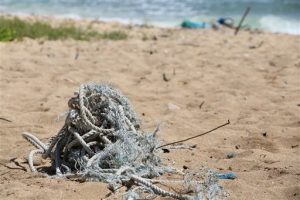
A study of the eight main Hawaiian Islands shows that ocean debris regularly accumulates around the archipelago, and that most of it is not linked to the March 2011 earthquake and tsunami in Japan, state officials said Tuesday.
The aerial survey shows that much of the debris that accumulates on the shores of Hawaii is from items discarded carelessly across the Pacific, officials with the state Department of Land and Natural Resources said in a statement. Ocean currents can bring trash from as far away as the U.S. mainland and Asia to the shores of Hawaii.
“In order to characterize the potential ecological consequences of tsunami and other debris, it’s important to quantify it,” said Kirsten Moy, the state’s marine debris coordinator. “Understanding the types, sizes and locations of debris accumulating on Hawaiian coastlines is crucial in developing plans to streamline removal and mitigate negative impacts.”
The debris, mostly plastics but also wood, household goods, fishing gear and other items, accumulates in hot spots around the islands, mostly on the north and east shores where ocean currents deposit the trash.
The study did not examine individual pieces of debris to determine where they came from, but rather looked at the sizes and types of trash, as well as their locations, to determine what amount was produced by the 2011 tsunami and earthquake in Japan and what was not.
“This survey found a very limited amount of debris associated with the Japan tsunami,” said Suzanne Case, chairwoman of the Department of Land & Natural Resources. “Most of what was mapped is common, everyday items that someone haphazardly tossed onto the ground or directly into the water.”
The island of Niihau had the most debris in the state with nearly 8,000 pieces of debris counted. Oahu, the state’s most populated island, had the least amount of debris with just under 1,000 pieces, most of which was found on the island’s northeastern tip.
The survey was paid for by the Ministry of Environment of Japan using the Japan Tsunami Gift Fund and commissioned by the Department of Land & Natural Resources and North Pacific Marine Science Organization.
The 2011 magnitude-9.0 earthquake off the coast of northern Japan unleashed a massive tsunami. More than 19,000 people were killed, and power to a nuclear plant was cut off, triggering multiple meltdowns in the world’s second-worst nuclear disaster.
Debris from the earthquake and tsunami has been found across the Pacific, including in Hawaii where Japanese boats and other items have washed ashore.
Note: The above post is reprinted from materials provided by The Associated Press.










